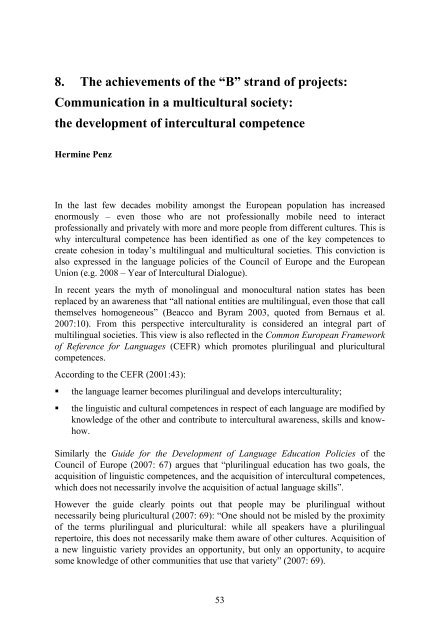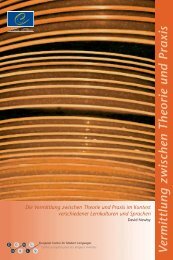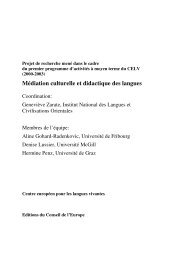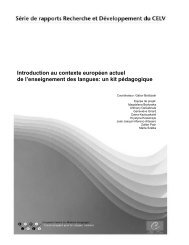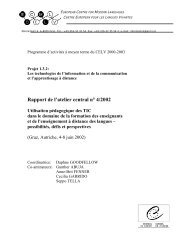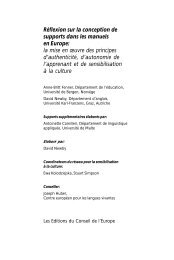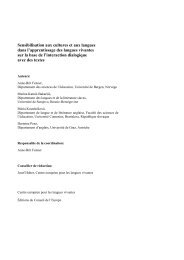cohesion - European Centre for Modern Languages
cohesion - European Centre for Modern Languages
cohesion - European Centre for Modern Languages
Create successful ePaper yourself
Turn your PDF publications into a flip-book with our unique Google optimized e-Paper software.
8. The achievements of the “B” strand of projects:<br />
Communication in a multicultural society:<br />
the development of intercultural competence<br />
Hermine Penz<br />
In the last few decades mobility amongst the <strong>European</strong> population has increased<br />
enormously – even those who are not professionally mobile need to interact<br />
professionally and privately with more and more people from different cultures. This is<br />
why intercultural competence has been identified as one of the key competences to<br />
create <strong>cohesion</strong> in today’s multilingual and multicultural societies. This conviction is<br />
also expressed in the language policies of the Council of Europe and the <strong>European</strong><br />
Union (e.g. 2008 – Year of Intercultural Dialogue).<br />
In recent years the myth of monolingual and monocultural nation states has been<br />
replaced by an awareness that “all national entities are multilingual, even those that call<br />
themselves homogeneous” (Beacco and Byram 2003, quoted from Bernaus et al.<br />
2007:10). From this perspective interculturality is considered an integral part of<br />
multilingual societies. This view is also reflected in the Common <strong>European</strong> Framework<br />
of Reference <strong>for</strong> <strong>Languages</strong> (CEFR) which promotes plurilingual and pluricultural<br />
competences.<br />
According to the CEFR (2001:43):<br />
the language learner becomes plurilingual and develops interculturality;<br />
the linguistic and cultural competences in respect of each language are modified by<br />
knowledge of the other and contribute to intercultural awareness, skills and knowhow.<br />
Similarly the Guide <strong>for</strong> the Development of Language Education Policies of the<br />
Council of Europe (2007: 67) argues that “plurilingual education has two goals, the<br />
acquisition of linguistic competences, and the acquisition of intercultural competences,<br />
which does not necessarily involve the acquisition of actual language skills”.<br />
However the guide clearly points out that people may be plurilingual without<br />
necessarily being pluricultural (2007: 69): “One should not be misled by the proximity<br />
of the terms plurilingual and pluricultural: while all speakers have a plurilingual<br />
repertoire, this does not necessarily make them aware of other cultures. Acquisition of<br />
a new linguistic variety provides an opportunity, but only an opportunity, to acquire<br />
some knowledge of other communities that use that variety” (2007: 69).<br />
53


